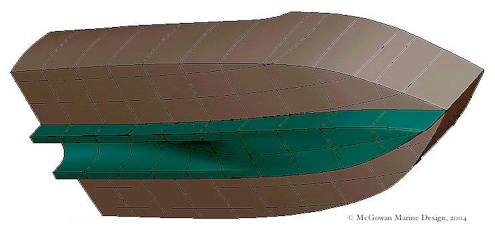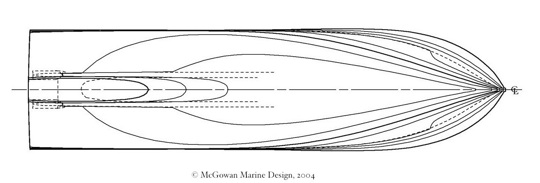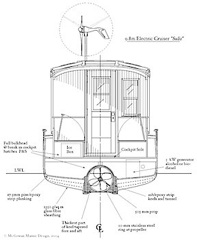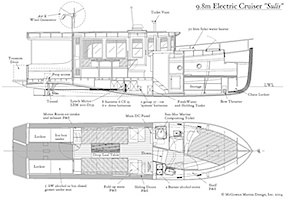
The bank of 8 premium 6v lead acid batteries should give Sulis 9 hours of cruising at 6 knots. This would discharge the batteries 80%. Super-duty lead acid batteries can handle that amount of discharge (especially with a 10 year warranty), but would not like the typical charging pattern of the solar system. The solar array, and wind generator shown would take 3 days to fully charge the depleted batteries during moderate sun and wind conditions. An occasional higher charge from the 5 kW generator should help keep sulfates from building up on cell plates. (NB: I’d suggest using AGM batteries today and not depleting the batteries that much!) It could also be used as a 'get home' power source. The Kyocera 1,270 Watt solar panels shown should provide 37 Amps of electricity on sunny summer days (1/2 rating due to flat orientation of panels). The Air X 400 W generator should provide excellent electricity generation on moderate to windy days. There is a separate 12V system for electronic equipment and lights.
Sulis… an electric cruiser for the 21st century.
* the name of an ancient British sun goddess, centred around the town of Bath.
** “Urchin Boat II” in Japanese. There was no v.1 name... but “2” rhymes with Maru
*** Inventor Cedric Lynch regained control of his company forming Agni Motors with partner
Copyright 2001-2021 inclusive McGowan Marine Design, Inc.
Sulis* is the product of years of drawing and thinking about a boat that could meet several power boating requirements, and one important environmental need… almost zero-emission travel. Sulis is the synthesis of a unique hull shape with an industry-leading, British electric drive motor. Hopefully, her classic looks and a practical layout combined with the solid economics of inexpensive battery charging and motoring will help bring about a shift in thinking about what a proper cruiser should be able to do. Hopefully soon the many unacceptable costs of oil production and internal combustion engine use will be left in the wakes of clean electric cruisers.
An explanation of Sulis' evolution might help to better describe the design. While fishing (diving) I often wondered what the ideal urchin boat might look like, and came to a few conclusions. The boat would need to be seaworthy and easy to operate in difficult weather and tides. It should have a shallow draught for picking up divers close to shore. The boat should be able to carry a large load without difficulty, and be economical to run. It should be easy to clear a fouled propeller (quite common), and the propeller should be shrouded to protect divers. The last point was hit home one unfortunate day three winters ago when I was run over while reaching the surface at the end of a dive. The captain hadn't seen me. While bumping along the bottom of the hull, the caged propeller whizzed by… too close for comfort. There was plenty of room for a hand or foot to slip through the cage.
Sulis - a 32’ (9.75m) Solar/Electric Cruiser

The resulting design, Uni Maru II ** was a boxy, arc-bottomed and hard chine design with a wide box keel that transformed into a semi-circular channel between two skegs aft (Fig. 2). The keel was an adaptation of one of Phil Bolger’s planing box keel designs.
It turns out the ideal urchin boat has the same requirements as the ideal coastal cruiser. The final evolution of the underwater part of the design was the addition of a full tunnel (nozzle) at the propeller, and a winged rudder at the end of each keel. (NB. the nozzle is now removed in newer designs... not needed) These features should provide for good propeller efficiency, excellent steering and directional stability with reduced rudder drag, and shallow draught. The addition of an access hatch aft of the propeller- for clearing lines in the prop- should make this type of design very handy for dive boats, for work vessels operating in messy harbours… and for cruisers. I’m calling the channel-plus-tunnel combination a Chunnel Jet. (This was a total suck-up to the British judges of the competition, but it didn’t work... I didn’t even win a pint of beer) Hopefully, variations of the hull type will prove to be useful and efficient for all types of work, cargo and pleasure craft that operate in displacement and semi-displacement modes.
Uni Maru II

Sulis has very fine lines for a (briefly) flat-bottomed boat. With an overall beam of 2.5m (8’4") she could be easily trailered by a full-sized pickup. The flat run, flat bottom and hard turns of the bilge aft should provide plenty of form stability. Having 1,300 kg of battery ballast low in the bilge should make the vessel very stable.
The electric drive motor chosen for Sulis is the LEM 200-D135, one of the ingenious motors of the Lynch Electric Motor, Co. of Devon, England***. Its excellent power/weight ratio, ability to operate cooly, plus its track record make it a natural for a cruiser. Tank testing of a model would help determine the hull's drag, propeller type and pitch, and ideal operating rpm.
Sulis Section
Sulis Plan and Elevation
Sulis' general arrangement is clear in the drawing (Fig. 5). The flaring 'shelf' forward provides increased living and working space in a very fine bowed boat.
The simple galley has an alcohol stove and sink. An icebox is located in a cockpit locker. Hot water would be available from a 50-litre above-deck passive solar water heater.
There is a hand pressurized 'mist' shower. The Sun-Mar™ composting toilet has a fan and heating element that could be switched to operate only when battery reserves allowed. The Sun-Mar biofilter plus a sprinkling of sawdust with each 'flush' should limit ammonia smells.
Sliding hatches and doors amidships should provide good access, light, and air to the cabin. The pilot and co-pilot seats fold up.


